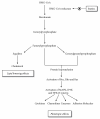Statins in the critically ill
- PMID: 22709377
- PMCID: PMC3488539
- DOI: 10.1186/2110-5820-2-19
Statins in the critically ill
Abstract
The use or misuse of statins in critically ill patients recently attracted the attention of intensive care clinicians. Indeed, statins are probably the most common chronic treatment before critical illness and some recent experimental and clinical data demonstrated their beneficial effects during sepsis, acute lung injury (ALI)/acute respiratory distress syndrome (ARDS), or after aneurismal subarachnoidal hemorrhage (aSAH). Due to the heterogeneity of current studies and the lack of well-designed prospective studies, definitive conclusions for systematic and large-scale utilization in intensive care units cannot be drawn from the published evidence. Furthermore, the extent of statins side effects in critically ill patients is still unknown. For the intensive care clinician, it is a matter of individually identifying the patient who can benefit from this therapy according to the current literature. The purpose of this review is to describe the mechanisms of actions of statins and to synthesize the clinical data that underline the relevant effects of statins in the particular setting of critical care, in an attempt to guide the clinician through his daily practice.
Figures


Similar articles
-
Statins for the prevention and treatment of acute lung injury and acute respiratory distress syndrome: A systematic review and meta-analysis.Respirology. 2016 Aug;21(6):1026-33. doi: 10.1111/resp.12820. Epub 2016 May 24. Respirology. 2016. PMID: 27221951
-
Feeding the critically ill obese patient: a systematic review protocol.JBI Database System Rev Implement Rep. 2015 Oct;13(10):95-109. doi: 10.11124/jbisrir-2015-2458. JBI Database System Rev Implement Rep. 2015. PMID: 26571286
-
The effectiveness of interventions to meet family needs of critically ill patients in an adult intensive care unit: a systematic review update.JBI Database System Rev Implement Rep. 2016 Mar;14(3):181-234. doi: 10.11124/JBISRIR-2016-2477. JBI Database System Rev Implement Rep. 2016. PMID: 27532144 Review.
-
Extracorporeal lung support technologies - bridge to recovery and bridge to lung transplantation in adult patients: an evidence-based analysis.Ont Health Technol Assess Ser. 2010;10(5):1-47. Epub 2010 Apr 1. Ont Health Technol Assess Ser. 2010. PMID: 23074408 Free PMC article.
-
To Block or Not: Updates in Neuromuscular Blockade in Acute Respiratory Distress Syndrome.Ann Pharmacother. 2020 Sep;54(9):899-906. doi: 10.1177/1060028020910132. Epub 2020 Feb 28. Ann Pharmacother. 2020. PMID: 32111121 Review.
Cited by
-
Effects of statins on the incidence and outcomes of acute kidney injury in critically ill patients: a systematic review and meta-analysis.Arch Med Sci. 2023 Jan 27;19(4):952-964. doi: 10.5114/aoms/159992. eCollection 2023. Arch Med Sci. 2023. PMID: 37560738 Free PMC article. Review.
-
Statin use and Vital Organ Failure in Patients With Asthma-Chronic Obstructive Pulmonary Disease Overlap: A Time-Dependent Population-Based Study.Front Pharmacol. 2019 Aug 16;10:889. doi: 10.3389/fphar.2019.00889. eCollection 2019. Front Pharmacol. 2019. PMID: 31474854 Free PMC article.
-
Cardiovascular Pathophysiology, Epidemiology, and Treatment Considerations of Coronavirus Disease 2019 (COVID-19): A Review.CJC Open. 2020 Sep 5;3(1):28-40. doi: 10.1016/j.cjco.2020.09.003. eCollection 2021 Jan. CJC Open. 2020. PMID: 33458630 Free PMC article. Review.
-
The association of statins use with survival of patients with COVID-19.J Cardiol. 2022 Apr;79(4):494-500. doi: 10.1016/j.jjcc.2021.12.012. Epub 2021 Dec 22. J Cardiol. 2022. PMID: 34974938 Free PMC article.
-
Peroxisome Proliferator-Activated Receptor Alpha Mediates the Beneficial Effects of Atorvastatin in Experimental Colitis.Front Immunol. 2021 Aug 9;12:618365. doi: 10.3389/fimmu.2021.618365. eCollection 2021. Front Immunol. 2021. PMID: 34434187 Free PMC article.
References
-
- Haute Autorité de Santé. Efficacité et efficience des hypolipemiants. Paris: une analyse centrée sur les statines; 2010.
-
- Stagnitti MN. Medical Expenditure Panel Survey: Statistical Brief #205. Rockville: Agency for Healthcare Research and Quality; 2008. Trends in statins utilization and expenditures for the U.S. civilian noninstitutionalized population, 2000 and 2005. - PubMed
-
- The Scandinavian Simvastatin Survival Study Group. Randomised trial of cholesterol lowering in 4444 patients with coronary heart disease: The Scandinavian Simvastatin Survival Study (4S) Lancet. 1994;344:1383–1389. - PubMed
-
- Shepherd J, Cobbe M, Ford I. et al.Prevention of coronary heart disease with pravastatin in men with hypercholesterolemia. West of Scotland Coronary prevention study group. N Engl J Med. 1995;333:1301–1307. - PubMed
LinkOut - more resources
Full Text Sources

